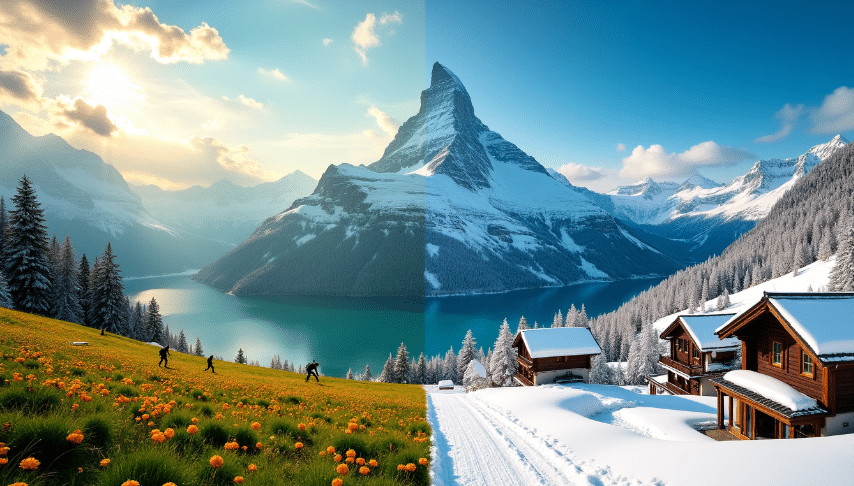Are you an iOS user and want to use iMessage when traveling? Here's all the information you need to ...
Travel Guides
Switzerland’s stunning landscapes and year-round attractions make it a top destination for outdoor lovers and culture seekers alike. This guide breaks down the best times to visit—whether you’re chasing summer hikes, winter slopes, or off-season savings.


Switzerland is one of Europe’s most iconic destinations, known for its majestic Alps, stunning lakes, and vibrant cultural scene. In fact, around 17 to 20 million international tourists visit Switzerland every year, eager to explore its natural beauty and world-class attractions. Whether you’re planning to hike through the Alps or enjoy the thrill of winter sports, knowing the best time to visit Switzerland will help you make the most of your adventure.
The best time to go to Switzerland is between May and September when the weather is mild and perfect for outdoor activities. However, if you’re a winter sports enthusiast, you may prefer visiting between December and March for the prime skiing and snowboarding season.
The country has four distinct seasons, each offering its own unique attractions. Here’s a breakdown to help you choose the best time based on your interests:
Temperatures range from 8°C to 15°C (46°F to 59°F), making it a great time for hiking and sightseeing. March starts off cooler, with highs of around 10°C, but by May, temperatures warm up to 15°C.
Expect fewer crowds and lower prices compared to the summer months. While the weather can be unpredictable, it’s ideal for outdoor activities, especially in the Swiss Alps, where hiking trails start to open back up.
If you’re looking for quieter travel, spring offers great opportunities for exploring Swiss cities and enjoying the beauty of blooming wildflowers.
Summer in Switzerland offers ideal conditions for outdoor activities, with temperatures ranging from 18°C to 28°C (64°F to 82°F). June starts with average highs around 22°C, and by July and August, cities like Zürich and Geneva can see temperatures reaching 28°C. This season is perfect for hiking, biking, and exploring Switzerland's stunning lakes.
The summer months also bring cultural festivals to cities across the country, such as the Montreux Jazz Festival and the Lucerne Festival.
However, since this is the peak travel season, you can expect larger crowds and higher prices, especially in popular destinations like the Swiss Alps.
Temperatures range from 8°C to 15°C (8°C to 15°C), with September typically seeing highs of 18°C before cooling down to around 8°C by November. Fall offers some of the most picturesque landscapes, perfect for enjoying the colorful foliage in the Swiss Alps.
If you’re a fan of wine tasting or cultural exploration, fall is the perfect time to visit. September is especially ideal as it marks the grape harvest season, and various autumn festivals take place throughout the country.
This season also brings lower prices and fewer tourists, making it great for those who want to experience Switzerland without the summer crowds.
Switzerland’s winter months are a paradise for snow sports enthusiasts. Skiing, snowboarding, and other winter activities dominate the agenda, with temperatures typically ranging from -2°C to 5°C (28°F to 41°F). January is the coldest month, with averages around 0°C, while February sees slightly milder conditions.
The Swiss Alps offer excellent snowfall, particularly from January to February, creating the ideal conditions for skiing and snowboarding. Winter festivals like Art on Ice and the International Hot Air Balloon Festival also add to the charm of the season. However, be prepared for higher accommodation costs during the peak winter months, especially at ski resorts.
Here’s a quick summary of average seasonal temperatures, precipitation levels and key considerations for each season in Switzerland:
| Season | Months | Average Temperatures | Precipitation | Considerations |
| Spring | March–May | 8°C–15°C (46°F–59°F) | Moderate | Mild weather with occasional rain; pack layers. |
| Summer | June–August | 18°C–28°C (64°F–82°F) | High | Peak season, crowded with higher prices and frequent rain. |
| Fall | September–November | 8°C–15°C (46°F–59°F) | Moderate | Cooler, fewer tourists, and colorful landscapes. |
| Winter | December–February | -2°C–5°C (28°F–41°F) | Low to moderate (mostly snow) | Best for snow sports; resort prices peak. |
Switzerland is a country that knows how to celebrate throughout the year, with its calendar packed full of exciting events and festivals. From adrenaline-pumping ski races in the heart of winter to vibrant music festivals in the summer, there’s always something to experience no matter when you visit.
Whether you're drawn to cultural traditions, world-class sporting events, or festive markets, these events provide a glimpse into the rich and diverse heritage of Switzerland.
Here's a month-by-month guide to some of the most notable celebrations and happenings across the country.
Switzerland may have a reputation for being a pricey destination, but that doesn’t mean you can’t enjoy everything it has to offer on a budget. The key to making your trip more affordable is timing it right.
By traveling during the off-peak season or shoulder season, you can save on everything from accommodation to activities.
During the off-peak season, Switzerland offers a more budget-friendly experience, especially when it comes to accommodation and activities. While certain attractions may be closed or less accessible due to colder weather, the quieter atmosphere and reduced prices make it a great time for those looking to save.
Here’s a breakdown of typical costs during the off-peak season:
Note: Prices can vary depending on the city, with Zurich and Geneva being among the most expensive in Switzerland.
In the shoulder season, accommodation prices rise slightly, with mid-range hotels averaging CHF 150–200 per night. However, meal prices, drinks, and entrance fees remain the same as in the off-peak season, making it an affordable time to visit.
The pleasant weather and fewer crowds provide great value, allowing you to enjoy the beauty of Switzerland without the peak-season rush.
To stretch your budget even further, here are a few simple tips:
To experience the best of Switzerland, plan for at least seven to 10 days. This gives you enough time to visit the major cities, explore the Swiss Alps and take part in outdoor activities.
If you're more into hiking or skiing, you might want to add a few extra days to make the most of your adventure. It’s all about balancing city exploration with outdoor pursuits.
Switzerland’s diverse landscapes and cultural gems make it a dream destination. Here are some of the top places to include in your itinerary:
If you’re a U.S. citizen planning a trip to Switzerland as a tourist, you don’t need a visa for stays of up to three months. However, your U.S. passport must be valid for at least three months beyond the date you plan to leave the Schengen area, which includes Switzerland.
This means as long as your trip is under 90 days and your passport meets the validity requirement, you’re all set to enjoy Switzerland without any additional paperwork.
Switzerland offers solid WiFi connectivity, especially in urban areas. Most hotels, cafes, and public spaces like airports and train stations provide free WiFi. However, speeds can vary in rural or mountain areas, so it's good to check ahead if you need reliable internet access for work or other needs.
Staying connected while traveling in Switzerland is a breeze with plenty of options beyond just public Wi-Fi. Many travelers opt for eSIM providers, such as Holafly, Saily, or Airalo. These services let you access data without needing a physical SIM card, offering flexible plans perfect for short trips.
If you’d rather stick to the classic route, Swiss telecom providers such as Swisscom, Sunrise, and Salt offer SIM cards that are easy to use and available locally. They have affordable data plans, but just remember your phone needs to be unlocked to use them.
For those traveling with multiple devices or in groups, renting a portable Wi-Fi router can be a great option. This way, you’ll have a reliable connection wherever you go, keeping everyone online throughout the trip.
In cities like Zurich, Geneva, and Lucerne, you’ll also find a lot of cafes, hotels, and restaurants with free Wi-Fi. Just be mindful of security risks when using public networks, and it’s always a good idea to use a VPN to keep your browsing safe.
Staying connected while traveling through Switzerland is easy with eSIM technology, which allows you to use data without needing to swap out SIM cards. Below are three popular eSIM providers, offering flexible plans that suit a variety of travel needs.
Holafly offers unlimited data eSIM plans tailored for tourists in Switzerland. This provider is perfect for travelers who want to use their devices without worrying about running out of data. The plans are easy to activate, and there’s no need to top up as long as your plan is active.
Saily offers a flexible range of data options for travelers. Their service is known for its affordability and convenience, with eSIMs that can be activated directly from your phone without extra steps. They provide a good balance between cost and coverage, ideal for those who need reliable data access without breaking the bank.
Airalo is a popular eSIM provider offering competitive pricing with global coverage. It’s known for its user-friendly interface and the ability to purchase eSIMs for multiple countries, making it a great option for travelers planning to visit multiple destinations. While coverage is generally reliable, data speeds can vary in more remote regions.
Here’s a table comparing the plans and pricing for the three eSIM providers mentioned above:
| Provider | Plans | Pricing |
| Holafly | Unlimited data | $5.90 |
| Saily | 1 GB, 3 GB, 5 GB, 10 GB, 20 GB | $3.99–$33.99 |
| Airalo | 1 GB, 2 GB, 3 GB, 5 GB, 10 GB, 20 GB | $4.50–$38,00 |
The most affordable time to visit Switzerland is during the off-peak months (November–March) or shoulder seasons (April–May, September–October).
The most expensive time to visit is during the peak summer months (June–August) and the winter ski season (December–March), when accommodation and activity prices, especially in ski resorts, are at their highest.
Seven to 10 days is recommended to explore both cities and outdoor activities without feeling rushed.

